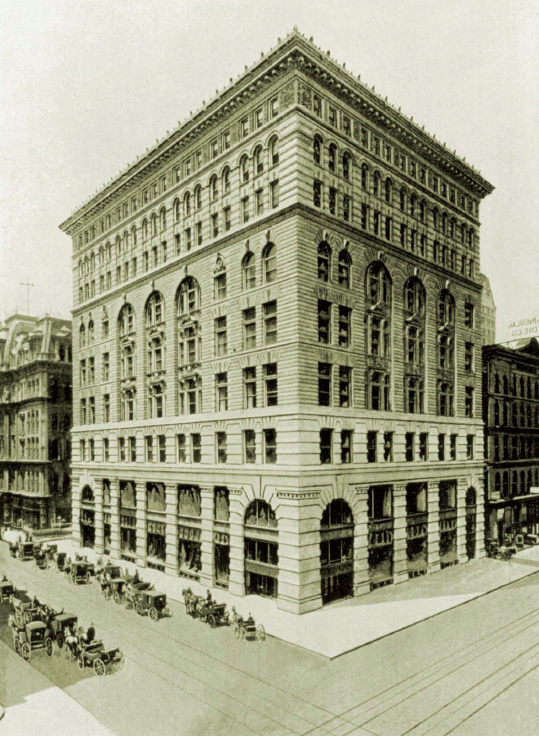Exploring American Histories: Printed Page 573
Exploring American Histories, Value Edition: Printed Page 472
Cities Expand Upward and Outward

As the urban population increased, cities expanded both out and up. Before 1860, the dominant form of brick and stone construction prevented buildings from rising more than four or five stories. As late as 1880, church steeples usually remained the tallest structures in cities. However, as cities became much more populous, land values soared. During the 1870s and 1880s, one piece of property in Chicago rose in value from $160 to $800. In Denver, the value of a city block leaped from $6,500 to $205,000, and in New York City a lot that sold for $80 in 1840 fetched $8,000 forty years later. Steep prices prompted architects to make the most of small, expensive plots of land by finding ways to build taller structures. Architects began using cast-iron columns instead of the thick, heavy walls of brick that limited floor space. The resulting “cloudscrapers” raised the urban skyline to ten stories. The development of structural steel, which was stronger and more durable than iron, turned cloudscrapers into skyscrapers, which stretched some thirty stories into the air. With the development of the electric elevator and the radiator, which replaced fireplaces with hot water circulated through pipes, even taller skyscrapers came to loom over downtown business districts in major cities.
Cities also expanded horizontally, as new transpor-tation technology made it possible for residents to move around a much larger urban landscape. In the mid-nineteenth century in cities such as Boston and Philadelphia, pedestrians could still walk from one end of the city to the other within an hour. If residents preferred to ride public conveyances, they could pay a fare and hop on board a horse-drawn railcar. These vehicles moved slowly and left tons of horse manure in the streets. To avoid such problems, in 1873 San Francisco, followed by Seattle and Chicago, installed a system of cable-driven trolley cars. Still, these trolleys proved slow and unreliable. By 1914, however, advances in transportation converted walking cities into riding cities.
Electricity provided the transportation breakthrough. In 1888 naval engineer Frank J. Sprague, who had once worked for inventor Thomas Edison, completed the first electric trolley line in Richmond, Virginia. Electric-powered streetcars traveled twice as fast as horses and left little mess on the streets. Subways could run underground without asphyxiating passengers and workmen with a steam engine’s smoke and soot. Boston opened the first subway in 1897, followed by New York City in 1904.
Bridges spanning large rivers and waterways also helped extend the boundaries of the inner city. Railroad companies had originally worked out the details of constructing such bridges, but not until 1883 did they become the symbol of urban growth. In that year, the Brooklyn Bridge opened, connecting Manhattan with the city of Brooklyn. Designed and engineered by John Augustus Roebling, the bridge had taken thirteen years to complete and cost twenty men their lives. It stretched more than a mile across the East River and was broad enough for a footpath, two double carriage lanes, and two railroad lines. In addition, the bridge featured arches cut like giant cathedral windows. In looking up at its supporting cables, one observer marveled that they hung “like divine messages from above.” During its first year in operation, more than 11 million people passed over the bridge; today, more than 51 million vehicles cross the bridge each year.
The electrification of public transportation and the construction of bridges made it feasible for some people to live considerable distances from their workplace. In the eighteenth and nineteenth centuries, middle- and upper-class merchants and professionals usually lived near their shops and offices in the heart of the city, surrounded by their employees. After 1880, the huge influx of immigration brought large numbers of impoverished workers to city centers. The resulting traffic congestion and overcrowded housing pushed wealthier residents to seek more open spaces in which to build houses. The new electric trolley lines allowed middle-class urbanites to move miles away from downtown areas. With an investment of $2,000 to $10,000, a considerable sum in those days, they built roomy homes filled with modern conveniences on leafy streets. In 1850 the Boston metropolis spread in a radius of two to three miles around the city and had a population of 200,000. In 1900 suburban Boston ringed the city in a ten-mile radius, with a population of more than 1 million. Increasingly, cities divided into two parts: an inner commercial and industrial core housing the working class, and outer communities occupied by a wealthier class of white, older-stock Americans.